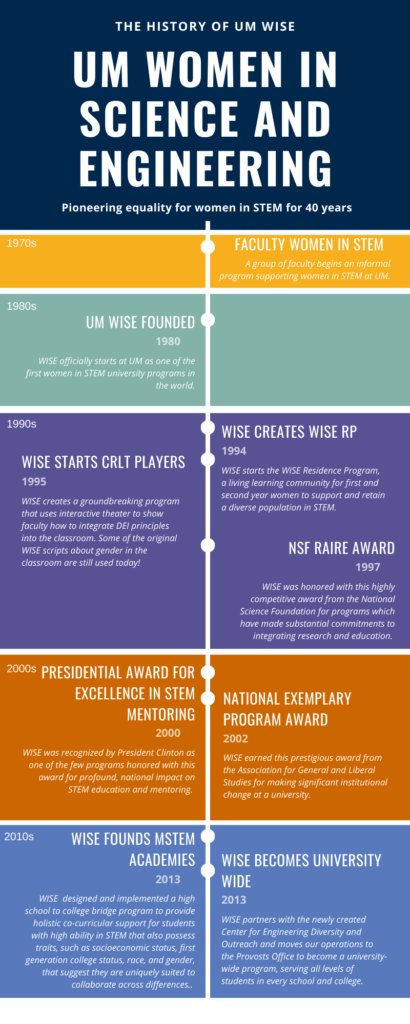
The University of Michigan Women in Science and Engineering unit is celebrating 40 years of pioneering equality for women.
1970s
- A group of faculty begins an informal program supporting women in STEM at U-M.
1980s
- 1980 – U-M WISE founded
WISE officially starts at U-M as one of the first university programs in the world for women in STEM.
1990s
- 1994 – WISE creates WISE RP
WISE starts the WISE Residence Program, a living-learning community for first and second year women to support and retain a diverse population in STEM. - 1995 – WISE starts CRLT Players
WISE creates a groundbreaking program that uses interactive thater to show faculty how to integrate DEI principles into the classroom. Some of the original WISE scripts about gender in the classroom are still used today! - 1997 – NSF RAIRE (Recognition Awards for the Integration of Research and Education) Award
WISE was honored with this highly competitive award from the National Science Foundation for programs which have made substantial commitments to integrating research and education.
2000s
- 2000 – Presidential Award for Excellence in STEM Mentoring
WISE was recognized by President Clinton as one of the few programs honored with this award for profound, national impact on STEM education and mentoring. - 2002 – National Exemplary Program Award
WISE earned this prestigious award from the Association for General and Liberal Studies for making significant institutional change at a university.
2010s
- 2013 – WISE founds MSTEM Academies
WISE designed and implemented a high school to college bridge program to provide holistic co-curricular support for students with high ability in STEM that also possess traits (such as socioeconomic status, first generation college status, race, and gender) that suggest that they are uniquely suited to collaborate across differences. - 2013 – WISE becomes university wide
WISE partners with the newly created Center for Engineering Diversity and Outreach and moves our operations to the Provost’s Office to become a university-wise unit, serving all levels of students in every school and college. - 2020 – WISE’s 40th Anniversary
The first 40 years of WISE brought about innovation, advocacy, and change that seemed inconceivable in 1980, but there is still work to do. WISE spent our anniversary creating rich, adaptable programming, actionable research, and new ways to reach students so that 2060 will exceed our wildest dreams for equity in STEM.